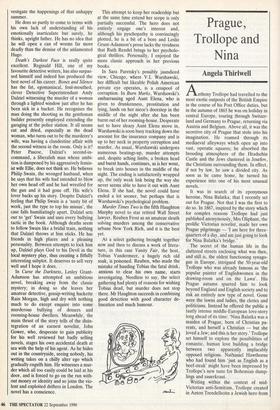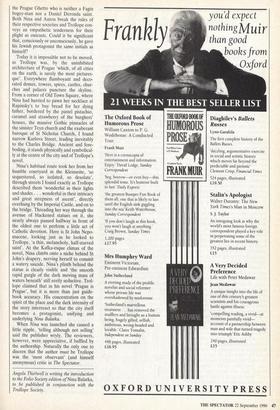Prague, Trollope and Nina
Angela Thirlwell
Anthony Trollope had travelled to the most exotic outposts of the British Empire in the course of his Post Office duties, but in the autumn of 1865 he was on holiday in central Europe, touring through Switzer- land and Germany to Prague, returning via Austria and Belgium. Above all, it was the secretive city of Prague that stole into his imagination. He roamed through its mediaeval alleyways which open up into vast, operatic squares; he absorbed the brooding atmosphere of the Hradschin Castle and the Jews clustered in Josefov, the Christians surrounding them. In effect, if not by law, he saw a divided city. As soon as he came home, he turned his experience into one of his most unusual novels.
It was in search of its eponymous heroine, Nina Balatka, that I recently set out for Prague. Not that I was the first to do so. In 1867, inspired by the story which for complex reasons Trollope had just published anonymously, Mrs Oliphant, the prolific Victorian novelist, made her own Prague pilgrimage — 'I am here for three- quarters of a day, and am just going to look for Nina Balatka's bridge.'
The secret of the human life in the cluttered streets enclosing what was then, and still is, the oldest functioning synago- gue in Europe, intrigued the 50-year-old Trollope who was already famous as 'the popular painter of Englishwomen in the drawing-room and on the Lawn'. His Prague autumn spurred him to look beyond England and English society and to risk an entirely new type of novel. Gone were the lawns and ladies, the clerics and politicians. Instead he offered the public a tautly intense middle-European love-story long ahead of its time: 'Nina Balatka was a maiden of Prague, born of Christian pa- rents, and herself a Christian — but she loved a Jew; and this is her story.' Trollope set himself to explore the possibilities of romantic, human love building a bridge between two apparently implacably opposed religions. Nathaniel Hawthorne who had found him 'just as English as a beef-steak' might have been impressed by Trollope's new taste for Bohemian dump- lings and sauerkraut.
Writing within the context of mid- Victorian anti-Semitism, Trollope created in Anton Trendellsohn a Jewish hero from the Prague Ghetto who is neither a Fagin bogey-man nor a Daniel Deronda saint.
Both Nina and Anton break the rules of their respective societies and Trollope con- veys an empathetic tenderness for their plight as outcasts. Could it be significant that, consciously or unconsciously, he gave Isis Jewish protagonist the same initials as himself?
Today it is impossible not to be moved, as Trollope was, by the uninhibited architecture of Prague 'which, of all cities on the earth, is surely the most pictures- que'. Everywhere flamboyant and deco- rated domes, towers, spires, castles, chur- ches and palaces puncture the skyline. From a corner of Old Town Square, where Nina had hurried to pawn her necklace at Rapinsky's to buy bread for her dying father, bordered by the pastel pistachio, caramel and strawberry of the burghers' houses, the massive Gothic pinnacles of the sinister Teyn church and the exuberant baroque of St Nicholas Church, I found narrow Karlova Street, leading inevitably to the Charles Bridge. Ancient and fore- boding, it stands physically and symbolical- ly at the centre of the city and of Trollope's novel.
Nina's habitual route took her from her humble courtyard in the Kleinseite, 'so sequestered, so isolated, so desolate', through streets I found exactly as Trollope described them 'wonderful in their lights and shades. . . wonderful in their intricacy and great steepness of ascent', directly overhung by the Imperial Castle, and on to the bridge. Threading her way through the avenue of blackened statues on it, she nearly always paused halfway in front of the oldest one to perform a little act of Catholic devotion. Here is St John Nepo- mucene, looking just as he looked to Trollope, 'a thin, melancholy, half-starved saint'. At the Kafka-esque climax of the novel, Nina climbs onto a niche behind St John's drapery, nerving herself to commit a watery suicide. Nina's plinth behind the statue is clearly visible and 'the smooth rapid gurgle of the dark moving mass of waters beneath' still eerily seductive. Trol- lope claimed that in his novel 'Prague is Prague', but it is more than just guide- book accuracy. His concentration on the spirit of the place and the dark intensity of the story interreact so that the city itself becomes a protagonist, unifying and underlying Nina Balatka.
When Nina was launched she caused a little ripple, 'telling although not selling' said the publisher wryly. The reviewers, however, were appreciative, if baffled by the authorship. Naturally the only one to discern that the author must be Trollope was the 'most observant' (and himself anonymous) critic in The Spectator.
Angela Thirlwell is writing the introduction to the Folio Society edition of Nina Balatka, to be published in conjunction with the Trollope Society.



































































 Previous page
Previous page